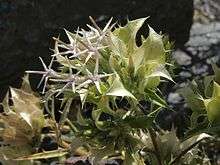Hecastocleis
| Prickleleaf | |
|---|---|
 | |
| Hecastocleis shockleyi flowering heads | |
| Scientific classification | |
| Kingdom: | Plantae |
| (unranked): | Angiosperms |
| (unranked): | Eudicots |
| (unranked): | Asterids |
| Order: | Asterales |
| Family: | Asteraceae |
| Subfamily: | Hecastocleidoideae |
| Genus: | Hecastocleis |
| Species: | H. shockleyi |
| Binomial name | |
| Hecastocleis shockleyi A.Gray | |
Hecastocleis is a genus of plants in the daisy family containing the single species Hecastocleis shockleyi.[1][2] It is known by the common name prickleleaf. This plant is native to the desert mountains and plains of eastern California (Inyo, Mono, Kern, + San Bernardino Counties) and southern Nevada (Mineral, Esmeralda, Nye, Lincoln, + Clark Counties), where it grows on arid, rocky slopes and flats.[3][4][5][6]
Description
This is a low, brambly shrub producing a tangle of stiff, branching stems reaching heights between 40 and 70 centimeters. The stems have sparse glandular hairs and are lined with small pointed green leaves with a row of widely spaced spines along each edge. As the leaf dries and its flesh falls away, the spines remain as hard prickles.[4]
At the end of each flowering branch is a dense cluster of narrow flower heads, the entire cluster enclosed by flat, oval-shaped, sharply toothed, leaflike, pale green to straw colored bracts resembling holly leaves. Each head in the cluster contains a single flower with a white to pinkish corolla, surrounded by narrow greenish phyllaries. The corollas are mostly radially symmetric, rarely bilaterally symmetric. The fruit is a cylindrical achene.[4][6]
The cluster of heads is sometimes referred to as a secondary head, and it resembles the primary head of other members of the daisy family.
Classification
Hecastocleis shockleyi is the only species in the subfamily Hecastocleidoideae of the aster family (Asteraceae). Botanists at least as early as Asa Gray (in 1882) remarked on its distinctiveness; it appears to have no close relatives within the aster family.[7][8]
References
- ↑ Gray, Asa. 1882. Proceedings of the American Academy of Arts and Sciences 17: 220–221 description in Latin, commentary in English
- ↑ Tropicos, Hecastocleis A. Gray
- ↑ Biota of North America Program 2013 county distribution map
- 1 2 3 Flora of North America, Vol. 19, 20 and 21 Page 71, Hecastocleis A. Gray
- ↑ Calflora, Hecastocleis shockleyi A. Gray, Shockley's prickleleaf, prickleleaf
- 1 2 Cronquist, A; Holmgren, AH; Holmgren, NH; Reveal, JL; Holmgren, PK (1994). Intermountain Flora: Vascular Plants of the Intermountain West, U.S.A. 5. New York Botanical Garden. pp. 422,425. ISBN 0-89327-375-9.
- ↑ Panero, JL; VA Funk (2002-12-30). "Toward a phylogenetic subfamilial classification for the Compositae (Asteraceae)" (PDF). Proceedings of the Biological Society of Washington (Biological Society of Washington) 115 (4): 909–922. Retrieved 2008-06-12.
- ↑ Stevens, P (2001 onwards). "Angiosperm Phylogeny Website". Missouri Botanical Garden. Retrieved 2007-08-05. Check date values in:
|date=(help)